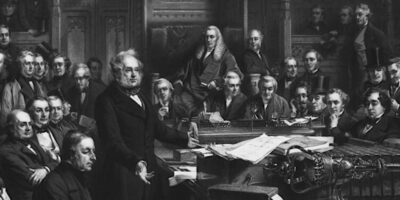What Is Your Coffee Cup’s Country of Origin?
The trade deficit just soared to a record $891 billion. This is said to be a setback for the US President. By Trump’s own standards, that’s true. But there is another sense in which it is not a setback for anyone. The calculation is not only unscientific; even if it were possible to label everything as being from somewhere, it just doesn’t matter for any reasons that are economically significant.
Branding products with national origin dates to the ancient world. The purpose was marketing. It’s nice to know that this urn came from Greece, that wine from Australia, and these stacking dolls from Russia. Silk from China! Fruit from Latin America! As mass prosperity began to dawn in the late medieval period, the market for things from all over the world was exploding as never before, and that meant telling where things are from.
Even today, we are thrilled to own little things from different parts of the world. To do that requires we continue to establish a country of origin.
That’s fine until the bureaucrats start mandating such reporting. And that’s been happening for the better part of a century. When states got involved in this business, that came with silly data reporting, e.g. the trade deficit. It’s supposed to measure the relationship between imports and exports, presuming that all goods come from only one place.
National origin designations are essential for its very calculation. Here is where things become extremely tricky, so much so that the statistics become meaningless, especially in a global economy with supply chains so complicated that it would require a dissertation to deconstruct the full origins of any household product.
Let’s consider the coffee cup on my desk. It is a branded mug for the American Institute for Economic Research. I love it so much!
Let’s think this through. It is pushing an institution founded in 1933 as an American institution. It is called the American Institute for Economic Research. Employees at this American institution thought of making it. We tapped an American supplier to manufacture them. We Americans are marketing it. We are selling it mostly to Americans.
This is obviously an American cup. Right? Ah, but turn the cup upside down. What does that little sticker say? “Made in China.” Wait, how did China get into this mix? The supplier we used for ordering the cup wholesale sought and found the most economically viable way to manufacture this thing. It can, therefore, sell it to us in a way that we can sell it to the consumer for $10. Everyone is happy.
Believe it or not, this thing is considered an import with China as its country of origin. It has thus contributed to the trade deficit, which Trump has cited as a disaster and evidence that China is “raping” this country. True story. I’m pretty sure this mug is doing no such thing.
If the mug was conceived in America, marketed in America, sold to Americans to push an American institution, why is China considered its country of origin? According to trade regulations, it must be counted that way because China is the country in which it experienced a “substantial transformation.”
That this is true doesn’t matter in the slightest bit to you, me, or anyone, except to the extent that we are thrilled to sell such a nice product for only $10 and the factory in China that put it together is happy to have the business.
And let there be no mistake, these regulations are seriously enforced. The mattress company Nectar was just read the riot act by the Federal Trade Commission for claiming that its products are “designed and assembled in the U.S.A,” when in fact they experienced “substantial transformation” in China. The company had to roll back its technically accurate claim. Basically, they were accused of fraud even though their mattresses truly were designed and assembled in the US.
The same fate befell three other businesses in recent months. The Democrats on the FTC have complained that the penalties are not severe enough!
There is another silly issue that is rarely mentioned here. As economist Donald Boudreaux points out constantly, the trade deficit only covers goods whereas 80% of American trading relationships consist of the exchange of services. In other words, the trade deficit describes nothing real. It is a statistical artifact as inaccurate as it is irrelevant.
National economic statistics in a global economy are already suspect, even more so when we are talking about products that depend for their very existence on international supply chains. At this point in history, where trading relationships cover every nation and production structures are infinitely complex, such data literally make no sense. To manufacture national data from globally manufactured commodities is to cram a large square peg in a very small round hole.
And yet here we have this one number built from a limited range of highly suspect data, signifying nothing meaningful at all, being massively misunderstood by the American political class and thereby causing havoc in US trade policy.
Fake economics in the wrong hands can cause an incredible amount of damage.












